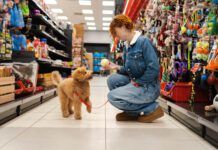Non-dog folks turn pale at the thought. But responsible dog owners, knowing how important it is to clean up after our dogs, think nothing of reaching down and picking up a fresh, fragrant pile of Fido’s feces with our hands. Oh, not our bare hands, of course, but often with nothing more than a couple of millimeters of flimsy plastic between epidermis and excrement. No big deal. Until, that is, one of those handy plastic bags breaks. Intrepid as committed poop-pickers may be, even we will blanche at the thought of . . . well, you can imagine.
WDJ applauds dog owners who pick up after their pooches. Tired of those “No Dogs Allowed” signs at all the parks in your area? Dog owners’ failure to scoop, and the resulting accumulation of feces, is one of the primary reasons that our best friends are banned from an increasing number of public places. This is not just an aesthetic problem. Roundworms and hookworms can infect humans, with children being most susceptible, since they are most likely to experience close encounters of the turd kind. The larva of these canine parasites can migrate and infest human liver, lungs and other organs (larval migrans syndrome). Infection may leave children with permanent vision or neurologic damage. Parvo-contaminated feces can also be a source of disease transmission to other dogs, particularly young puppies and elderly dogs whose immunities are weak, or dogs with compromised immune systems.
Both to encourage responsible scooping and to protect our stalwart readers from bag-breaking nightmares, we decided to determine which poop bags are the best on the market. Ready to delve with us into the depths of defecation disposal?
There are several factors to consider when selecting a dog poop bag:
1. Sturdiness is high on the list – no explanation needed.
2. Holding Capacity. Again, self-explanatory. A Pomeranian pile is a different story from a Great Pyrenees production.
3. Cost. Pennies for poop? Or dollars for defecation?
4. Disposability. Ecology is always a consideration with our WDJ approved products. Will our landfills overflow with little bags full of doggie bowel movements? Or do the bags break down and decompose; ashes to ashes, feces to fertilizer?
5. Sealability. This is important. Once you have done the deed, can you close the container to prevent errant odors from contaminating your conversations?
6. Aesthetics. This may be more important to some dog-folk than others, but there are bags you can see through and bags you can’t. All else being equal, you might generally prefer not to be able to view the contents of the container once you have carefully captured them.





